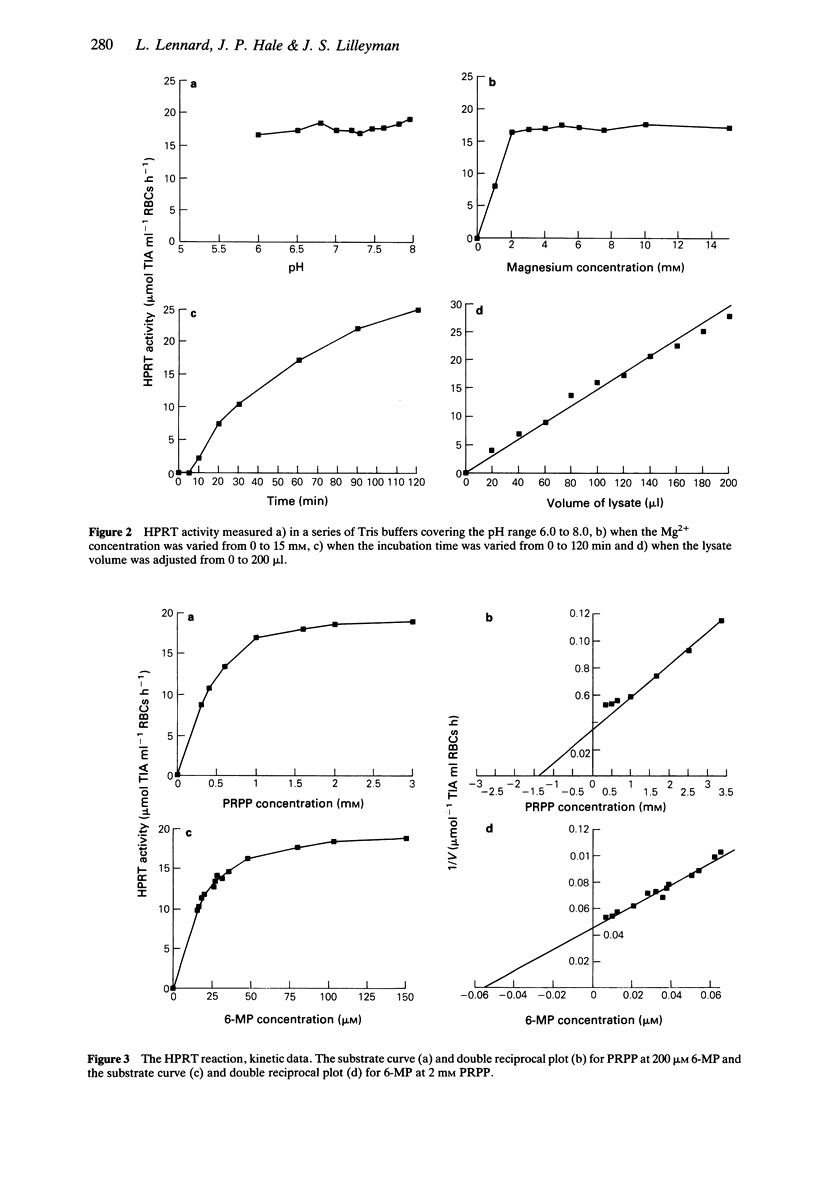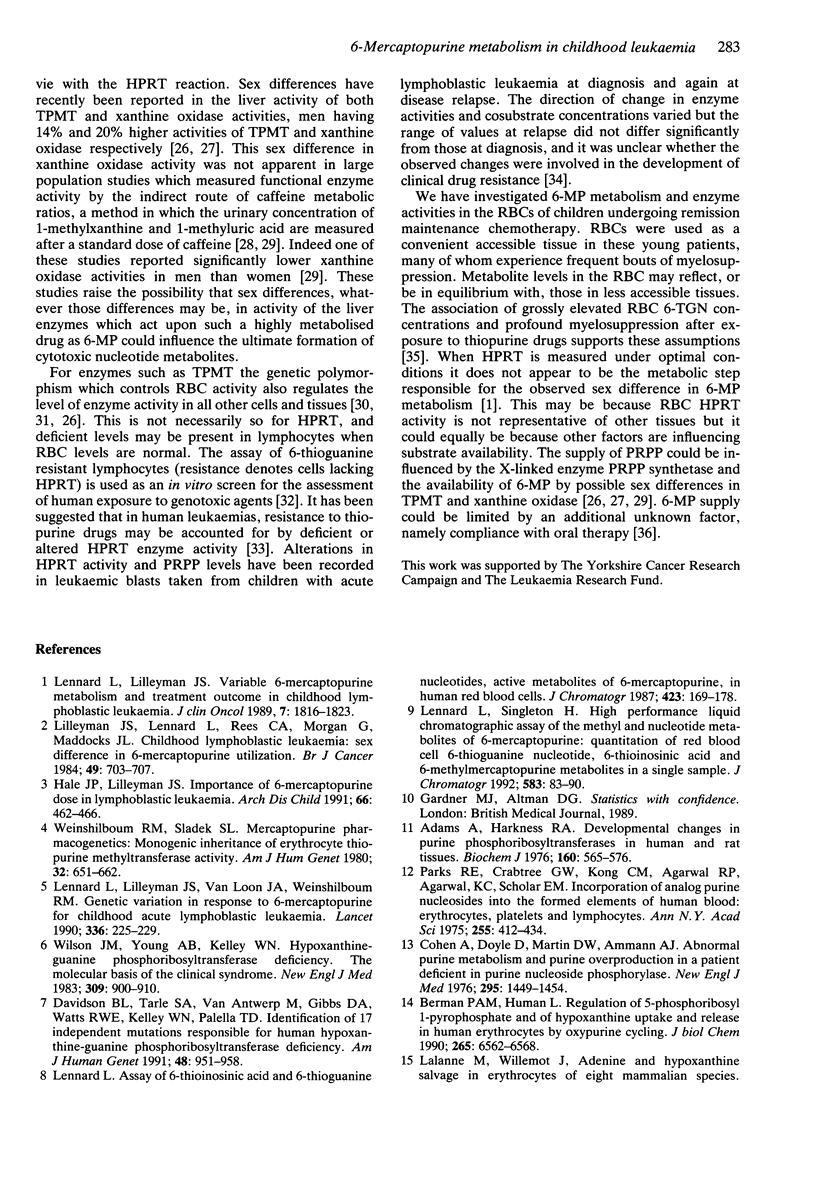Abstract
1. 6-Mercaptopurine (6-MP) is used in the continuing chemotherapy of childhood acute lymphoblastic leukaemia. The formation of red blood cell (RBC) 6-thioguanine nucleotide (6-TGN) active metabolites, not the dose of 6-MP, is related to cytotoxicity and prognosis. But there is an apparent sex difference in 6-MP metabolism. Boys require more 6-MP than girls to produce the same range of 6-TGN concentrations. Given the same dose, they experience fewer dose reductions because of cytotoxicity, and have a higher relapse rate. 2. The enzyme hypoxanthine phosphoribosyltransferase (HPRT) catalyses the initial activation step in the metabolism of 6-MP to 6-TGNs, a step that requires endogenous phosphoribosyl pyrophosphate (PRPP) as a cosubstrate. Both HPRT and the enzyme responsible for the formation of PRPP are X-linked. 3. RBC HPRT activity was measured in two populations, 86 control children and 63 children with acute lymphoblastic leukaemia. 6-MP was used as the substrate and the formation of the nucleotide product, 6-thioinosinic acid (TIA) was measured. RBC 6-TGN concentrations were measured in the leukaemic children at a standard dose of 6-MP. 4. There was a 1.3 to 1.7 fold range in HPRT activity when measured under optimal conditions. The leukaemic children had significantly higher HPRT activities than the controls (median difference 4.2 micromol TIA ml(-1) RBCs h(-1), 95% C.I. 3.7 to 4.7, P < 0.0001). In the leukaemic children HPRT activity (range 20.4 to 26.6 micromol TIA ml(-1) RBCs h(-1), median 23.6) was not related to the production of 6-TGNs (range 60 to 1,024 pmol 8 x 10(-8) RBCs, median 323). RBC HPRT was present at a high activity even in those children with low 6-TGN concentrations. 5. When HPRT is measured under optimal conditions it does not appear to be the metabolic step responsible for the observed sex difference in 6-MP metabolism. This may be because RBC HPRT activity is not representative of other tissues but it could equally be because other sex-linked factors are influencing substrate availability.
Full text
PDF







Selected References
These references are in PubMed. This may not be the complete list of references from this article.
- Adams A., Harkness R. A. Developmental changes in purine phosphoribosyltransferases in human and rat tissues. Biochem J. 1976 Dec 15;160(3):565–576. doi: 10.1042/bj1600565. [DOI] [PMC free article] [PubMed] [Google Scholar]
- Berman P. A., Human L. Regulation of 5-phosphoribosyl 1-pyrophosphate and of hypoxanthine uptake and release in human erythrocytes by oxypurine cycling. J Biol Chem. 1990 Apr 25;265(12):6562–6568. [PubMed] [Google Scholar]
- Buesa-Perez J. M., Leyva A., Pinedo H. M. Effect of methotrexate on 5-phosphoribosyl 1-pyrophosphate levels in L1210 leukemia cells in vitro. Cancer Res. 1980 Jan;40(1):139–144. [PubMed] [Google Scholar]
- Bökkerink J. P., Bakker M. A., Hulscher T. W., De Abreu R. R., Schretlen E. D., van Laarhoven J. P., De Bruyn C. H. Sequence-, time- and dose-dependent synergism of methotrexate and 6-mercaptopurine in malignant human T-lymphoblasts. Biochem Pharmacol. 1986 Oct 15;35(20):3549–3555. doi: 10.1016/0006-2952(86)90625-8. [DOI] [PubMed] [Google Scholar]
- Bökkerink J. P., De Abreu R. A., Bakker M. A., Hulscher T. W., Van Baal J. M., De Vaan G. A. Dose-related effects of methotrexate on purine and pyrimidine nucleotides and on cell-kinetic parameters in MOLT-4 malignant human T-lymphoblasts. Biochem Pharmacol. 1986 Oct 15;35(20):3557–3564. doi: 10.1016/0006-2952(86)90626-x. [DOI] [PubMed] [Google Scholar]
- Cadman E., Heimer R., Davis L. Enhanced 5-fluorouracil nucleotide formation after methotrexate administration: explanation for drug synergism. Science. 1979 Sep 14;205(4411):1135–1137. doi: 10.1126/science.472732. [DOI] [PubMed] [Google Scholar]
- Cohen A., Doyle D., Martin D. W., Jr, Ammann A. J. Abnormal purine metabolism and purine overproduction in a patient deficient in purine nucleoside phosphorylase. N Engl J Med. 1976 Dec 23;295(26):1449–1454. doi: 10.1056/NEJM197612232952603. [DOI] [PubMed] [Google Scholar]
- Davidson B. L., Tarlé S. A., Van Antwerp M., Gibbs D. A., Watts R. W., Kelley W. N., Palella T. D. Identification of 17 independent mutations responsible for human hypoxanthine-guanine phosphoribosyltransferase (HPRT) deficiency. Am J Hum Genet. 1991 May;48(5):951–958. [PMC free article] [PubMed] [Google Scholar]
- Davies H. A., Lennard L., Lilleyman J. S. Variable mercaptopurine metabolism in children with leukaemia: a problem of non-compliance? BMJ. 1993 May 8;306(6887):1239–1240. doi: 10.1136/bmj.306.6887.1239. [DOI] [PMC free article] [PubMed] [Google Scholar]
- Grant D. M., Tang B. K., Kalow W. Variability in caffeine metabolism. Clin Pharmacol Ther. 1983 May;33(5):591–602. doi: 10.1038/clpt.1983.80. [DOI] [PubMed] [Google Scholar]
- Guerciolini R., Szumlanski C., Weinshilboum R. M. Human liver xanthine oxidase: nature and extent of individual variation. Clin Pharmacol Ther. 1991 Dec;50(6):663–672. doi: 10.1038/clpt.1991.205. [DOI] [PubMed] [Google Scholar]
- Hale J. P., Lilleyman J. S. Importance of 6-mercaptopurine dose in lymphoblastic leukaemia. Arch Dis Child. 1991 Apr;66(4):462–466. doi: 10.1136/adc.66.4.462. [DOI] [PMC free article] [PubMed] [Google Scholar]
- Henderson J. F., Brox L. W., Kelley W. N., Rosenbloom F. M., Seegmiller J. E. Kinetic studies of hypoxanthine-guanine phosphoribosyltransferase. J Biol Chem. 1968 May 25;243(10):2514–2522. [PubMed] [Google Scholar]
- Hüttner E., Mergner U., Braun R., Schöneich J. Increased frequency of 6-thioguanine-resistant lymphocytes in peripheral blood of workers employed in cyclophosphamide production. Mutat Res. 1990 Feb;243(2):101–107. doi: 10.1016/0165-7992(90)90030-n. [DOI] [PubMed] [Google Scholar]
- Johnson L. A., Gordon R. B., Emmerson B. T. Hypoxanthine-guanine phosphoribosyltransferase: a simple spectrophotometric assay. Clin Chim Acta. 1977 Oct 1;80(1):203–207. doi: 10.1016/0009-8981(77)90280-7. [DOI] [PubMed] [Google Scholar]
- Krenitsky T. A., Papaioannou R., Elion G. B. Human hypoxanthine phosphoribosyltransferase. I. Purification, properties, and specificity. J Biol Chem. 1969 Mar 10;244(5):1263–1270. [PubMed] [Google Scholar]
- Lennard L. Assay of 6-thioinosinic acid and 6-thioguanine nucleotides, active metabolites of 6-mercaptopurine, in human red blood cells. J Chromatogr. 1987 Dec 25;423:169–178. doi: 10.1016/0378-4347(87)80340-7. [DOI] [PubMed] [Google Scholar]
- Lennard L., Lilleyman J. S., Van Loon J., Weinshilboum R. M. Genetic variation in response to 6-mercaptopurine for childhood acute lymphoblastic leukaemia. Lancet. 1990 Jul 28;336(8709):225–229. doi: 10.1016/0140-6736(90)91745-v. [DOI] [PubMed] [Google Scholar]
- Lennard L., Lilleyman J. S. Variable mercaptopurine metabolism and treatment outcome in childhood lymphoblastic leukemia. J Clin Oncol. 1989 Dec;7(12):1816–1823. doi: 10.1200/JCO.1989.7.12.1816. [DOI] [PubMed] [Google Scholar]
- Lennard L., Singleton H. J. High-performance liquid chromatographic assay of the methyl and nucleotide metabolites of 6-mercaptopurine: quantitation of red blood cell 6-thioguanine nucleotide, 6-thioinosinic acid and 6-methylmercaptopurine metabolites in a single sample. J Chromatogr. 1992 Nov 27;583(1):83–90. doi: 10.1016/0378-4347(92)80347-s. [DOI] [PubMed] [Google Scholar]
- Lennard L., Van Loon J. A., Weinshilboum R. M. Pharmacogenetics of acute azathioprine toxicity: relationship to thiopurine methyltransferase genetic polymorphism. Clin Pharmacol Ther. 1989 Aug;46(2):149–154. doi: 10.1038/clpt.1989.119. [DOI] [PubMed] [Google Scholar]
- Lilleyman J. S., Lennard L., Rees C. A., Morgan G., Maddocks J. L. Childhood lymphoblastic leukaemia: sex difference in 6-mercaptopurine utilization. Br J Cancer. 1984 Jun;49(6):703–707. doi: 10.1038/bjc.1984.111. [DOI] [PMC free article] [PubMed] [Google Scholar]
- Parks R. E., Jr, Crabtree G. W., Kong C. M., Agarwal R. P., Agarwal K. C., Scholar E. M. Incorporation of analog purine nucleosides into the formed elements of human blood: erythrocytes, platelets, and lymphocytes. Ann N Y Acad Sci. 1975 Aug 8;255:412–434. doi: 10.1111/j.1749-6632.1975.tb29249.x. [DOI] [PubMed] [Google Scholar]
- Relling M. V., Lin J. S., Ayers G. D., Evans W. E. Racial and gender differences in N-acetyltransferase, xanthine oxidase, and CYP1A2 activities. Clin Pharmacol Ther. 1992 Dec;52(6):643–658. doi: 10.1038/clpt.1992.203. [DOI] [PubMed] [Google Scholar]
- Rosman M., Williams H. E. Leukocyte purine phosphoribosyltransferases in human leukemias sensitive and resistant to 6-thiopurines. Cancer Res. 1973 Jun;33(6):1202–1209. [PubMed] [Google Scholar]
- Szumlanski C. L., Honchel R., Scott M. C., Weinshilboum R. M. Human liver thiopurine methyltransferase pharmacogenetics: biochemical properties, liver-erythrocyte correlation and presence of isozymes. Pharmacogenetics. 1992 Aug;2(4):148–159. [PubMed] [Google Scholar]
- Tattersall M. H., Harrap K. R. Combination chemotherapy: the antagonism of methotrexate and cytosine arabinoside. Eur J Cancer. 1973 Mar;9(3):229–232. doi: 10.1016/s0014-2964(73)80023-4. [DOI] [PubMed] [Google Scholar]
- Tax W. J., Veerkamp J. H. A simple and sensitive method for estimating the concentration and synthesis of 5-phosphoribosyl 1-pyrophosphate in red blood cells. Clin Chim Acta. 1977 Jul 15;78(2):209–216. doi: 10.1016/0009-8981(77)90308-4. [DOI] [PubMed] [Google Scholar]
- Van Loon J. A., Weinshilboum R. M. Thiopurine methyltransferase biochemical genetics: human lymphocyte activity. Biochem Genet. 1982 Aug;20(7-8):637–658. doi: 10.1007/BF00483962. [DOI] [PubMed] [Google Scholar]
- Weinshilboum R. M., Sladek S. L. Mercaptopurine pharmacogenetics: monogenic inheritance of erythrocyte thiopurine methyltransferase activity. Am J Hum Genet. 1980 Sep;32(5):651–662. [PMC free article] [PubMed] [Google Scholar]
- Wilson J. M., Young A. B., Kelley W. N. Hypoxanthine-guanine phosphoribosyltransferase deficiency. The molecular basis of the clinical syndromes. N Engl J Med. 1983 Oct 13;309(15):900–910. doi: 10.1056/NEJM198310133091507. [DOI] [PubMed] [Google Scholar]
- Wong P. C., Hey Y., Fowler J. S. A fluorimetric assay of the phosphoribosylation of 6-mercaptopurine in human blood cells. Clin Chim Acta. 1979 Nov 15;99(1):43–51. doi: 10.1016/0009-8981(79)90138-4. [DOI] [PubMed] [Google Scholar]
- Woodson L. C., Dunnette J. H., Weinshilboum R. M. Pharmacogenetics of human thiopurine methyltransferase: kidney-erythrocyte correlation and immunotitration studies. J Pharmacol Exp Ther. 1982 Jul;222(1):174–181. [PubMed] [Google Scholar]
- Zimm S., Reaman G., Murphy R. F., Poplack D. G. Biochemical parameters of mercaptopurine activity in patients with acute lymphoblastic leukemia. Cancer Res. 1986 Mar;46(3):1495–1498. [PubMed] [Google Scholar]


